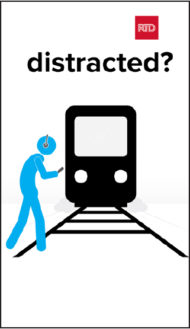
A passenger running to catch his train stepped in front of an oncoming train after he passed through the gate pictured at left. RTD says the signals were working properly. With a ticket booth to the west, passengers need to step right up to the gate to fully view the tracks to the west.
Are Bells, Lights, Gates and Signs Not Enough?
Passengers returning from the July 3 Rockies game on RTD’s A-line train witnessed the second accidental train-pedestrian fatality at Central Park Station (and system-wide); in April a distracted passenger crossing the tracks was hit by a train. RTD’s Chief Safety and Security Officer Mike Meader says video reveals the man hit by the train on July 3 saw the incoming train before choosing to cross the tracks. “He went to the first set [of gates]…looked in the direction of the train coming and…thought he could beat the train…he hesitated for just a second and then started running.” Though first responders arrived within minutes, Meader confirms that the man died the following day.

Passengers cross the tracks to exit.
Stapleton resident and daily A-line commuter Jessica Plante McGraw was on the train that hit the man. “I was thrilled when the A-line opened,” she says. “But I was shocked that you have to walk across the tracks to catch the train.” She appreciates that personal responsibility is a factor in safety, but feels that not having train horns combined with the visual barrier created by the ticket kiosk make the station unsafe. “You see the train approaching, and you hear the crossing signals going, but the train itself is not that loud….at the west side of that platform is the ticketing station. And so if you’re approaching and you see your train in front of you and you hear and see the signals you think ‘those lights and sounds are for the train that I’m staring at.’ You’re not thinking of the train that is coming from the opposite direction, that you can’t see or hear….and you have that ticketing station obstructing your view.”

Flowers left on a gate in memorial to the man who died in July.
Meader counters that visibility is not an issue. “If you walk…to where the pedestrian gates are, there is a very clear line of sight if you stop at the gate.” He adds that bright flashing signs with the crossbuck symbol, bells sounding at an uncomfortable 86 decibels, and a sign that says, “second train coming” all alert people to incoming trains. Meader says RTD is always evaluating safety and is considering some systems that will result in “behavioral modifications” to boost safety, including a “Z-gate” that funnels pedestrians in a Z-shape so they have to see oncoming trains. Pedestrian behavior, however, is critical to safety around trains. Even the best systems do not work if people choose to ignore them. “If your intention is to get across the tracks, be it a good idea or not, you’re going to get across those tracks,” he says.
Sam Goldsmith, who commutes to his Larimer Square office daily using the A-line, says he sees a lot of people racing for the train. Although he describes himself as “a pretty cautious individual,” he admits that the rush to catch the train sometimes supplants caution. “As a matter of fact, today, if I had been with my wife or kid, I would have been yelled at because of how aggressive I was. I stood right by the train as it passed, and then literally opened the gate within a millisecond of it passing to catch it.”
 Goldsmith does see RTD security on site, however, trying to curb dangerous behaviors. He recalls staff recently reprimanding a man skateboarding on the platform. He wonders if more tourists than locals are being unsafe, and suggests something like an audio or video loop to educate people, similar to the audio DIA tram riders hear, might reduce accidents. Goldsmith works in an industry that centers on risk mitigation and emphasizes the importance of effective education to change behavior.
Goldsmith does see RTD security on site, however, trying to curb dangerous behaviors. He recalls staff recently reprimanding a man skateboarding on the platform. He wonders if more tourists than locals are being unsafe, and suggests something like an audio or video loop to educate people, similar to the audio DIA tram riders hear, might reduce accidents. Goldsmith works in an industry that centers on risk mitigation and emphasizes the importance of effective education to change behavior.
RTD’s Tina Jaquez says the Federal Transit Administration (FTA) mandates the creation of a Safety Management System (SMS) for certain rail operators receiving federal funds. According to the FTA website, “…the rule calls on agencies to report their Safety Management Policy and processes for safety risk management, safety assurance and safety promotion.” RTD has begun implementing SMS, which is a data-based, pro-active approach to safety that includes observing pedestrian behaviors system-wide. Central Park and Peoria St. stations, which have the most near-misses and are among the busiest stations, were among the first to be studied.




0 Comments